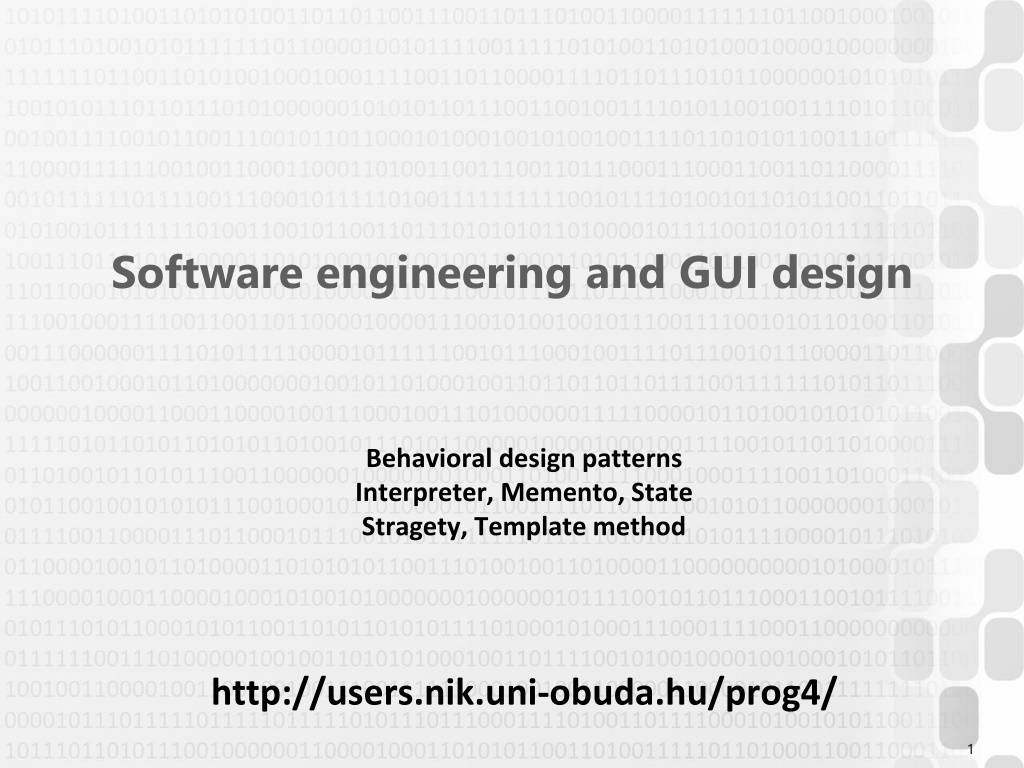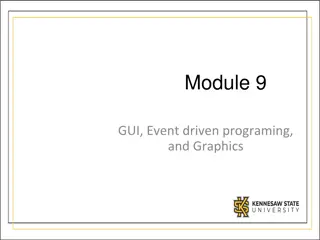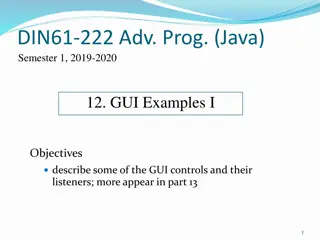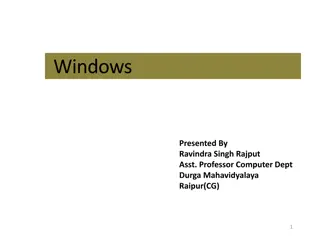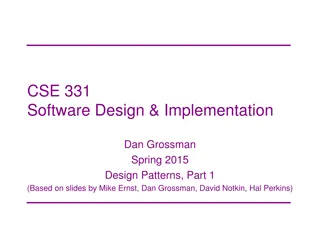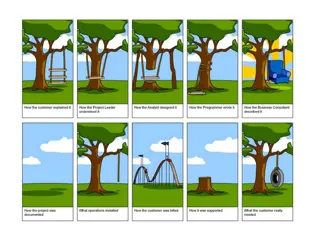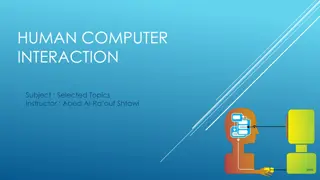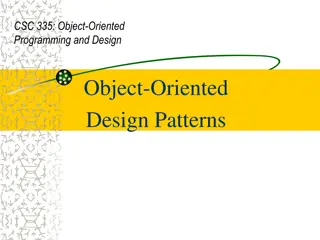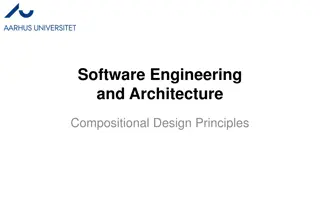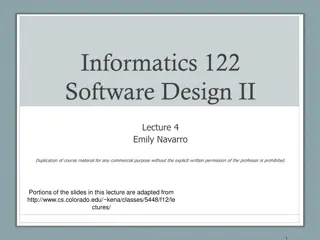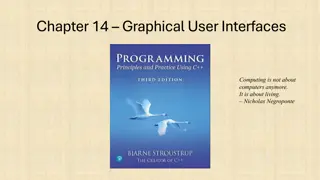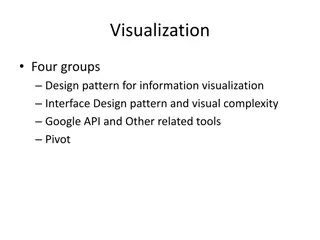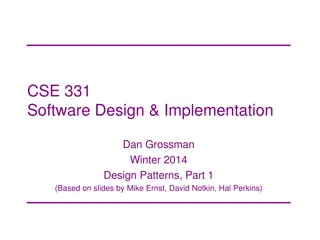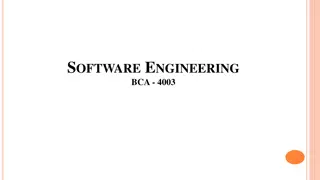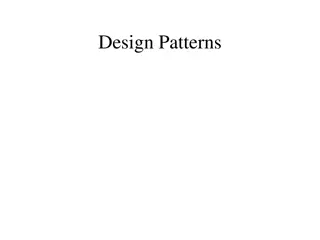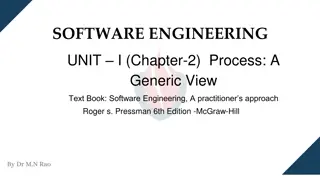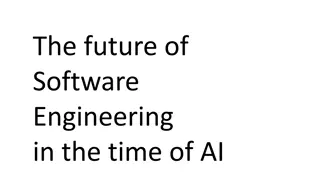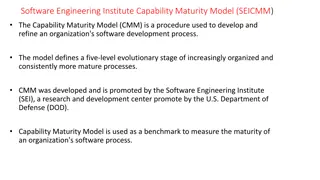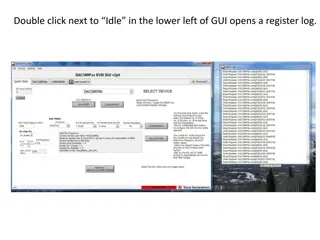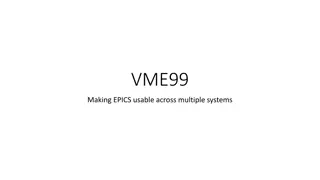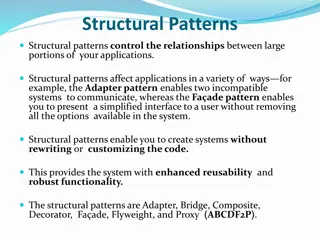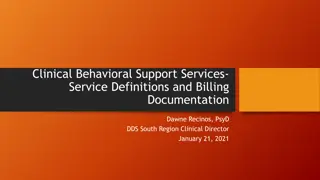Guide to Behavioral Design Patterns in Software Engineering and GUI Design
Learn about key behavioral design patterns such as Interpreter, Memento, State, Strategy, and Template Method in software engineering and GUI design. Understand their purposes, implementation techniques, and when to use them effectively. Explore how these patterns enhance the design and functionality of software systems.
Download Presentation

Please find below an Image/Link to download the presentation.
The content on the website is provided AS IS for your information and personal use only. It may not be sold, licensed, or shared on other websites without obtaining consent from the author. Download presentation by click this link. If you encounter any issues during the download, it is possible that the publisher has removed the file from their server.
E N D
Presentation Transcript
Software engineering and GUI design Behavioral design patterns Interpreter, Memento, State Stragety, Template method http://users.nik.uni-obuda.hu/prog4/ 1
Purpose Design pattern Short description Iterator Behavioral foreach () { } Chain of resp. Execute a process using multiple process executors Visitor Separate caller and called instance multiple visitors/visitees: IVisitor.Visit(IVisitorAcceptor) IVisitorAcceptor.Accept(IVisitor) Command Encapsulate a request/method call into an instance Observer Separate caller and called instance (using events) Mediator Fully separate caller and called instance (using central hub) State State instances that control state transitions Interpreter Convert arbitrary input to arbitrary output Memento Restore previous state Strategy Full implementation/process in the descendants Depend on abstract base class in constructor Dependency injection (via Abstract) Template method Define individual steps in the descendants Usage of virtual methods and method polymorphism 2
Behavioral Design Patterns Purpose Creational Structural Behavioral Factory method Adapter Interpreter Template method Scope Class Abstract factory Builder Prototype Singleton Adapter Bridge Composite Decorator Facade Flyweight Proxy Chain of responsibility Command Iterator Mediator Memento Observer State Strategy Visitor Object 3
Interpreter expression ::= literal | alternation | sequence | repetition | '(' expression ')' alternation ::= expression '|' expression sequence ::= expression '&' expression repetition ::= expression '*' literal ::= 'a' | 'b' | 'c' | ... { 'a' | 'b' | 'c' | ... }* 4
Interpreter raining & (dogs | cats) * 5
Interpreter In principle: using formal language/grammar rules of expressions, convert arbitrary input to arbitrary output Too generic, rarely useable, complicated pattern Only useable with simple languages (with a complex grammar, the class hierarchy can get extremely complex) The class hierarchy is not optimal regarding memory and cpu issues, either For example, regular expressions are processed using much more efficient and faster state machine methods instead of slow and painful syntax trees 7
Interpreter C# This is a more common use case: an Expression will not produce a final output on its own, but rather multiple Expressions are called after each other, and they gradually modify the output property of the context 12
Memento Save and restore previous state Originator = original object Memento = store a single state (OOP: private class?) Caretaker = handle multiple states (OOP: private class?) The Originator is responsible for saving its own state into a Memento instance, and restore its state from a Memento instance 17
Memento C# The Save() s parameter: the important data (the full instance is rare, as most of the times, private datafields are also saved) 18
Memento C# 19
Memento C# 20
Memento C# 21
State Memento state = full object state, the important data fields/properties State state = one single data field, that stores the current status of the instance 22
State State chains can get complex, especially with many states / state transitions Without the pattern: spagetti-code , same or similar chain of complex checks in multiple business logic methods 23
State Implementation alternatives Common implementation rules Context class, with a single State property Every different state requires a different suitable class The state-classes have state-changing methods In the state-changing methods, we perform business logic checks / conditions and then we change the state: Variants State-changing methods = business logic methods E.g. bug tickets, Proposed, Open, Resolved, Closed MoveForward(), MoveBackward(), Reject(), Reopen() State-changing method = a single state supervisor method E.g. bank accounts, Bronze, Silver, Gold Deposit(), Withdraw(), PayInterest() 24
State variant 1 Typical modell: State Transition Table F(currentState, operation) Conditions + New state Pro VERY easy, clear structure Easy to extend Every code has its clear place Con Many states, many BL MANY2 methods, mostly empty (STT: 1 cell = 1 method; UML State Diagram: 1 possible arrow = 1 method) S OLID violation? Does not define logic, but knows about Can be good if you have few states/operations but lots of state changes (implements them into a good structure) Disturbing if many states/operations (LOTS OF empty methods) 27
State variant 2 Typical model: UML state diagram Prettier solution Better suited for the SOLID principles The state classes have ZERO business logic code No unnecessary empty methods However: we extract the state changed from the Context class, BUT the Context must know when a state change might occur this is not obviously nice The EnsureState() method can get too complex Every state in the UML diagram means one EnsureState method With complex state systems, this method can get too big Solution: Chain of Responsibility, but this increases the number of classes 31
Behavioral Design Patterns Purpose Creational Structural Behavioral Factory method Adapter Interpreter Template method Scope Class Abstract factory Builder Prototype Singleton Adapter Bridge Composite Decorator Facade Flyweight Proxy Chain of responsibility Command Iterator Mediator Memento Observer State Strategy Visitor Object 32
Strategy, Template method Basic patterns describing the main OOP principles Describes the meaningful use of virtual methods (S OL ID) Dependency injection (with abstract classes: SOLI D ) Related (structural) patterns: Adapter, Bridge Used every day, even with the most simple programs Strategy: a full operation is dependent on the descendant class (DI with base class) Template: the operation is defined by the base class, some steps can be defined in the descendants (virtual methods, DI with base class) Adapter: How can we substitute a class/interface with a different one (DI with interface) Bridge: Decomposition of hierarchies (DI with base class) Dependency Injection??? GoF(1994); Martin Fowler (2004) 33
Strategy 34
Strategy C# 35
Strategy, Template method Practically the most widely used design patterns in any system (of any size!) Strategy: How to implement and use a library hierarchy? The base class (interface?) is fixed We write code that uses the base class Any descendant instance can be used later Our code calls the hierarchy s code Template: How to implement and use a framework? The base class defines the possibilities The base class is used by a full business logic/process We write code that utilizes the rules/possibilities of the base class (usually only a fraction of those) The externally defined business process will call our code 39
Strategy = ASP.NET Core Identity A completely generic approach, does not care which descendant (= login implementation) is used PROG3, PROG4: The Logic does not care which data storage implementation is used 40
Template = MVC Framework PROG4 During the render process, the WPF will SOMEWHERE call the OnRender() method of the FrameworkElement descendants WPF will SOMEHOW call the event handler/Command member ASP.NET will SOMEHOW call the Action handler method 41
Thank you for your attention Behavioral design patterns Interpreter, Memento, State Stragety, Template method http://users.nik.uni-obuda.hu/prog4/ 42
